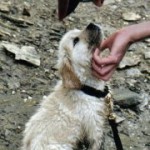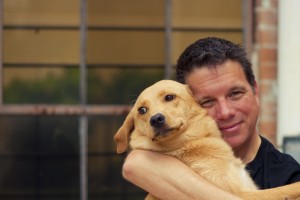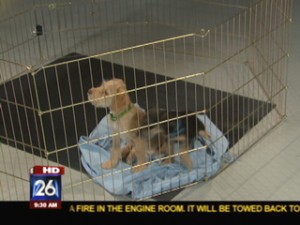Michael Baugh CPDT-KA, CDBC
We teach our dogs to jump on us. I hope that comes as no surprise. Watch how we interact with dogs, especially puppies. They run to new people with boundless excitement and jump up to greet them. We love it, right? Puppies are small and adorable. We bend down to pet them, chat them up with a little baby talk and sometimes even pick them up so they can kiss our faces. Puppies learn from almost day-one that the best way to get the ultimate human interactive experience is to, you guessed it, jump on them.

It hardly seems fair that about 5 months into the process we decide to change the rules on them. But of course that’s exactly what we do. Adolescent puppies can be big and awkward. We may not have learned to trim their nails yet, so those are sharp enough to hurt us. Our puppy still runs with that boundless energy but he’s faster and stronger. Now that cute puppy just seems rude to us. But watch what people do even with older puppies. The dog jumps. We still pet. I’ve seen it hundreds of times. Even if we don’t like the dog’s jumping we still seem compelled to reward it with petting.
Stop. If we’re going to change the rules on our adolescent dog let’s at least be clear about it. No more petting for jumping. Let’s decide from now on the dog now gets nothing at all if there’s an accidental jumping episode: no touching, no talking, no nothin’. And be careful. There’s a trap here. Even punishment counts as interaction. Yelling at your dog for jumping or grabbing his paws or kneeing his chest are all reactions to his jumping (the latter can cause serious injury). Your dog is jumping to seek attention and sure enough you’re giving it to him. Stop.
Read on because this is only one part of the plan. And it’s the hardest part. Cutting off reinforcement for bad behavior (above) is not the same as ignoring bad behavior. Please remember that. We’re actually paying very close attention to solving this problem. Admittedly, it is very hard to let a dog figure out on his own that jumping doesn’t work. As a trainer I have no problem putting on my jeans and an old t-shirt and letting a 6-month old Golden Retriever jump on my until she figures out I’m not responding to that behavior (it usually takes less than 5 minutes). But I also know you may not have the patience for it. Turning your back on the dog helps. Leaving the room helps. Patiently waiting with your arms folded and your gaze averted to the ceiling helps. You’ve heard all these solutions but they are only part of the plan.
We’ve left a bit of room for error here and I want to tidy that up. A lot of dogs will sit for us, get a treat or a pet and then jump on us. I guess jumping must feel really good. Or maybe they can’t contain themselves. No matter, there is the simple solution of behavior management here. Let your dog drag his leash around the house (I prefer a simple 6 foot leash). Make sure you only do this when you can supervise him. Definitely do it when guests are coming over. Now imagine that cute 6 month old Golden Retriever bolting up for you and sitting nicely. While you praise, pet or treat her, deftly step on that leash at the same time. If you hit the leash somewhere in the middle she won’t have much room to jump up on you even if she tries. The leash will stop her a few inches into that jump. It’s even easier to do with a visitor since you’ll have the leash in hand to start. Letting your guest greet the dog while you step on the leash gives your dog a chance to learn how to do it right. Of course dogs who are shuttled away to a crate or taken on a walk when guests come over do not suffer. But they also don’t learn how to greet properly either.
Okay, let’s review this stuff.
1. Stop reinforcing jumping: no petting, talking or even reacting in a punishing way. Turning your back or passively waiting for the jumping behavior to extinguish can work but it takes heroic patience. (See step 3).
2. Teach the right way for your dog to greet: always come when called and sit for pets, praise and treats (there are tons of reward-based trainers in town who teach this).
3. Finally, management: block jumping behavior by stepping on the leash. This helps prevent your dog from successfully practicing jumping on people.
I can already hear some keyboards clicking away with a response to this blog. Yes, I know you or you neighbor or your Uncle Ralph slapped a choke collar on and solved the jumping problem faster than lightning by whipping the dog into shape. Cool. I don’t teach that method for a number of reasons. But debating force-based training versus reward-based is not really what this blog is about.
That said, I invite you all to share your experiences. Better yet, post a picture of you and your dog. Few things in life are as nice as a picture of a person and a dog in happy times. They’re not with us that long. So, live it up.



